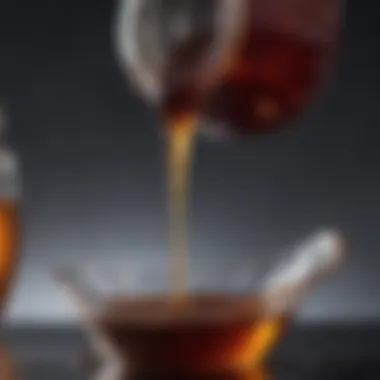Exploring Extra Dark Maple Syrup: A Comprehensive Guide


Intro
Extra dark maple syrup stands as a testament to the intricacies of nature’s sweetness, often overlooked in the broader landscape of culinary staples. While many may be familiar with the lighter varieties of maple syrup, the extra dark version offers a flavor profile that is complex and rich. It is not merely a sweetener; it is an ingredient that can transform dishes, adding depth and a unique character that delights the palate.
This article aims to illuminate the nuances of extra dark maple syrup, tracing its journey from tree to table. By delving into its production methods, taste characteristics, and nutritional benefits, we will unveil why this syrup deserves a prominent place in your kitchen. Additionally, we will explore how it can be integrated into a variety of recipes, showcasing its versatility in both classic and contemporary cooking.
Understanding the significance of extra dark maple syrup within gastronomy is crucial. Beyond its culinary uses, it reflects a cultural narrative of regional pride, sustainability, and the age-old practice of harvesting sap from maple trees. Whether you are a seasoned chef or a curious food lover, this guide will provide valuable insights into the world of extra dark maple syrup.
Understanding Maple Syrup
Understanding maple syrup is essential for appreciating its varieties and their culinary uses. Each type of maple syrup carries its own unique characteristics influenced by factors such as the season it is produced in and the methods of extraction used. Extra dark maple syrup, in particular, serves as a focal point in this exploration, known for its strong flavor and rich color.
The significance of this topic extends beyond mere taste. Maple syrup production is a deeply rooted tradition in regions with sugar maple trees, especially in North America. Recognizing these traditions adds layers to our understanding of food culture. Moreover, the nutritional aspects and culinary applications provide valuable insights into how each type can enhance dishes.
History of Maple Syrup
Maple syrup has a long and storied history. Indigenous peoples of North America were the first to tap maple trees, using the sap for fuel and nourishment. They passed this knowledge across generations, which laid the foundation for present-day practices. The advent of European settlers saw the introduction of more systematic methods for tapping and refining sap, eventually establishing maple syrup as a key agricultural product in regions such as Vermont and Quebec.
The history of maple syrup not only reflects agricultural practices but also intertwines with cultural identities. The seasonal cycles of tapping strive to connect communities and regions through celebration and ritual, showcasing the resilience and ingenuity of those who produce it.
Types of Maple Syrup
Different types of maple syrup are classified primarily by color and flavor. Each type fulfills various culinary needs. The following explains these types:
-#### Light Maple Syrup Light maple syrup, often enjoyed for its mild flavor, is typically produced early in the sugaring season. This syrup is often noted for its subtle sweetness and only a hint of maple flavor. It is an ideal choice for those who prefer a less intense taste. However, it may not be robust enough for recipes that require a strong maple presence.
-#### Medium Maple Syrup Medium maple syrup offers more flavor than its lighter counterpart while still maintaining a balance. This syrup is versatile, making it suitable for a range of applications from breakfast dishes to baked goods. It stands out due to its rich yet not overpowering maple taste. This balance allows cooks to use it without the fear of overshadowing other flavors.
-#### Amber Maple Syrup For those who seek a deeper flavor, amber maple syrup presents a suitable choice. It possesses a strong maple flavor, combining sweetness with notes of caramel. This syrup is often used in cooking and as a table syrup. Its unique feature lies in its ability to enhance dishes with its distinctive flavor, making it a popular option among culinary enthusiasts.
-#### Extra Dark Maple Syrup Extra dark maple syrup exhibits a bold flavor profile, characterized by its intense sweetness and robust maple notes. It is produced later in the season when the sap's sugar content is at its highest. This syrup is valuable for its versatility. It pairs well with savory dishes and can be used in sauces, glazes, and marinades. Its potential downside is that its intense flavor may overpower more delicate recipes. Thus, careful pairing with other ingredients is essential.
Understanding these types of maple syrup is pivotal for navigating the culinary landscape. Each variety contributes differently to recipes, providing a depth of flavor and enhancing overall gastronomic experiences.
Defining Extra Dark Maple Syrup
Extra dark maple syrup holds a significant place in gastronomy, appreciated for its robust flavor and unique properties. Understanding this syrup involves examining its production, taste profile, and utility in various culinary contexts. The exploration enhances appreciation for maple syrup's richness, particularly in its darkest form.
Production Process
Tapping Maple Trees
Tapping maple trees is a crucial initial step in producing extra dark maple syrup. This process involves drilling a small hole into the trunk of a sugar maple or black maple tree, allowing sap to flow out. The key characteristic of this method lies in its sustainability. Tapping does not harm the tree as long as proper techniques are used, making it a popular choice among producers. The unique feature of tapping is the seasonal timing; it must occur during the late winter or early spring when temperatures fluctuate above and below freezing. This temperature cycle is essential for sap production. While tapping is beneficial for gathering the sap, improper techniques can lead to tree damage.


Collecting Sap
After tapping, collecting sap takes center stage. Sap is usually gathered in buckets or through tubing systems. The prominent characteristic of collecting sap is its time-sensitive nature; sap must be collected quickly to maintain freshness. This process is beneficial as it ensures high-quality syrup production. A unique aspect is the sheer volume of sap needed; it typically takes about 40 gallons of sap to produce one gallon of syrup. This ratio illustrates the labor-intensive nature of production. However, in warm seasons, sap can spoil quickly, creating a short window for collection.
Boiling and Refining
Boiling and refining are the concluding stages in maple syrup production. This stage involves boiling collected sap to evaporate water, concentrating the sugars. The boiling process is essential as it transforms the sap into syrup and affects the final flavor. A key characteristic here is temperature control; syrup must reach a specific temperature to ensure proper consistency and sweetness. The unique part of boiling is watching the sap change from clear liquid to rich syrup, a visual and olfactory experience. Though highly effective, this process requires vigilance, as overheating can lead to burnt flavors.
Taste and Color Profile
Flavor Complexity
The flavor complexity of extra dark maple syrup is noteworthy. It presents a rich, strong taste with deep caramel notes. This syrup’s characteristic is its layered flavors, often described as more robust compared to lighter syrups. The benefit of such complexity is its ability to enhance various dishes, providing depth. An advantage is that it pairs well with savory items, contrasting with the usual sweetness associated with lighter syrups. However, its intensity can overpower delicate flavors if not used judiciously.
Color Variations
Color variations in extra dark maple syrup are significant indicators of its quality and processing stage. This syrup typically appears dark brown, signifying extensive boiling. The key aspect of color is that it relates directly to flavor intensity; darker syrup usually has a stronger taste. The beneficial choice of utilizing color variations is that they guide consumers in selecting syrups that best suit their culinary needs. The unique feature of color is how it can reflect the syrup’s age and quality. However, differences in color can confuse consumers unfamiliar with maple syrup production.
Culinary Applications
Culinary applications of extra dark maple syrup extend beyond mere sweetening. This rich syrup offers unique flavors that can enhance a variety of dishes. The depth of taste makes it ideal for different culinary uses. It can transform ordinary meals into extraordinary experiences. Understanding how to use extra dark maple syrup in your cooking can elevate your culinary skills. Therefore, this is an essential part of this guide.
Cooking with Extra Dark Maple Syrup
Sauces and Marinades
Sauces and marinades allow for a rich blend of flavors that complement meats, vegetables, and more. Extra dark maple syrup adds sweetness and depth that balances acidity and spice. Its distinct caramel notes give richness that is difficult to match with other sweeteners. Many chefs prefer it for barbecue sauces or salad dressings. It is a beneficial choice due to its versatility and complexity. The natural sugars in the syrup can also help with caramelization during cooking, adding to the texture and appeal of the dish.
Baking Applications
In baking, extra dark maple syrup can replace refined sugar. It brings a unique flavor profile to cakes, cookies, and bread. This syrup can add moisture, which is key for certain baked goods. People often choose it due to its lower glycemic index compared to white sugar. The challenge lies in adjusting the liquid content in recipes, as syrup is a wet ingredient. However, its ability to contribute to both taste and texture makes it a popular addition in many dessert recipes.
Glazing Meats and Vegetables
Glazing meats and vegetables with extra dark maple syrup creates a shiny, appealing finish. The syrup caramelizes beautifully, offering a sweet-salty contrast that works well with roasted items. Many enjoy experimenting with this technique, as it encourages creativity in the kitchen. It can enhance the flavors of dishes like glazed carrots or maple-basted ham.
Flavor Pairing
Complementary Ingredients
When considering complementary ingredients, extra dark maple syrup shines through diverse combinations. Its flavor profile works wonderfully with spices like cinnamon and nutmeg. Adding it to dishes enriched with citrus or rich cheeses creates a nice balance. This versatility makes it a favored choice among culinary enthusiasts. Importantly, it adds depth without overpowering other flavors, allowing for a harmonious blend in sweet and savory dishes alike.
Creating Balanced Dishes
Creating balanced dishes with extra dark maple syrup requires an understanding of flavors. Incorporating it into salads or grain bowls can add sweetness that cuts through bitterness. Its thick consistency can anchor a dish while enhancing presentation. The unique characteristic of its flavor allows it to be not just an additive, but an essential component of balanced profiles. This approach is beneficial as it leads to creativity in gastronomy and reflects a deep understanding of food development.


Nutritional Aspects
Understanding the nutritional aspects of extra dark maple syrup is essential for those who wish to incorporate it into their diet effectively. The perception of maple syrup often leans toward it being merely a sweetener. However, it offers a variety of nutritional components that can benefit health when consumed in moderation. This section explores its caloric content, vitamins, and minerals, as well as the associated health benefits.
Caloric Content
A common inquiry about extra dark maple syrup is its caloric content. One tablespoon typically contains around fifty calories. While this may seem modest, it can quickly add up depending on the serving size. Awareness of caloric intake is particularly important for individuals monitoring their weight or overall health. Extra dark maple syrup provides a quick source of energy, making it a satisfactory option before or after physical activities. However, given its high sugar content, moderation is critical to avoid excessive calorie consumption.
Vitamins and Minerals
Extra dark maple syrup contains various vitamins and minerals that can contribute to a balanced diet. The two main components worth discussing are:
Micronutrient Value
Extra dark maple syrup offers several micronutrients, including manganese and zinc, which are pivotal for several body processes. Manganese, in particular, plays a crucial role in metabolism as well as the formation of bone and connective tissue. Zinc serves as an essential mineral that assists in immune function as well as wound healing. The unique feature of micronutrient value is its ability to provide these nutrients in a delicious form, enhancing not just the flavor of dishes, but also their nutritional density.
Health Benefits
The health benefits of extra dark maple syrup extend beyond taste. Rich in antioxidants, it can help protect the body from oxidative stress. The syrup also contains compounds known for their anti-inflammatory properties. The key characteristic of these health benefits is their potential to complement a healthy diet rather than replace traditional sources of nutrients. This syrup serves as a flavorful alternative to refined sugars, making it an attractive choice for those looking to enjoy sweetness while still gaining some health advantages.
Cultural Significance
Cultural significance of extra dark maple syrup extends beyond its flavor and sweetness. It embodies traditions, regional pride, and culinary practices that reflect the identity of the communities that produce it. This syrup, with its rich taste and darker hue, is often associated with authenticity and depth in various cuisines. The discussion around cultural significance includes how production methods and consumption practices vary across different regions, highlighting the different heritages associated with maple syrup.
Regional Variations
Northern Territories
In the Northern Territories, the production of extra dark maple syrup is quite distinctive. The colder climate influences the sap's sugar content, which in turn affects the flavor profile of the syrup. The key characteristic of this region is its vast forest lands rich in sugar maples. This contributes to the high quality and unique taste of the syrup. Moreover, the practices in this area focus on sustainable harvesting methods, ensuring that the forest ecosystem remains healthy. Using traditional techniques and modern practices makes Northern Territories a popular choice for those interested in eco-friendly maple syrup production.
The unique feature of this region is its remote nature, which adds a layer of exclusivity to the syrup produced. However, the limited accessibility can also mean higher prices and less availability in mainstream markets.
New England Influence
New England has a long-standing relationship with maple syrup production. This area is known for establishing best practices and advancing techniques that have benefited syrup makers across North America. The climate in New England is ideal for tapping maple trees, resulting in high quality sap. The key characteristic here is the traditional methods still employed by many producers. This influence has helped maintain a steady demand for high-grade extra dark maple syrup, affirming its place in culinary culture.
The unique feature of New England is the vibrant community surrounding maple syrup. Producers often engage in festivals and events celebrating this product, thereby intensifying consumer interest. However, competition among producers also raises challenges in terms of pricing and marketing, making it vital for them to differentiate their product.
Traditions Surrounding Maple Syrup
Maple Festivals
Maple festivals hold great significance within communities that celebrate this syrup. These events not only showcase the production process but also foster a sense of community and pride in local agriculture. The key characteristic of these festivals is their ability to educate the public on the intricacies of syrup production, from tapping trees to tasting the final product. They also provide a platform for small producers to showcase their products, thus stimulating local economies.
One unique feature of maple festivals is the interactive experiences they offer, such as sap boiling demonstrations. This engagement promotes a deeper appreciation for the labor behind each bottle of syrup. However, the challenge is that these festivals are often seasonal, limiting opportunities for engagement year-round.


Culinary Heritage
Culinary heritage related to extra dark maple syrup showcases its use in traditional recipes passed down through generations. This historical aspect highlights how different cultures have incorporated maple syrup into their diets. The key characteristic of this heritage is the adaptability of maple syrup to a variety of dishes, whether it's savory or sweet. It is a crucial ingredient in many local cuisines, demonstrating its versatility.
The unique feature of culinary heritage is the blending of old recipes with modern interpretations. This evolving use helps to maintain the syrup's relevance in today's culinary world. However, the challenge lies in balancing tradition with innovation, ensuring that the essence of these time-honored recipes is not lost.
Sustainable Practices in Maple Syrup Production
Sustainable practices in maple syrup production are essential for ensuring the longevity and health of both the environment and the industry itself. As the demand for maple syrup, particularly extra dark maple syrup, continues to rise, careful consideration of sustainable methods is crucial. This section examines the significance of adopting eco-friendly techniques, their benefits, and practical considerations to enhance sustainability in syrup production.
Eco-Friendly Farming
Eco-friendly farming encompasses a range of practices aimed at minimizing environmental impact while maximizing productivity. Key elements include organic farming methods, reduced chemical use, and responsible land management. For maple syrup producers, adopting eco-friendly techniques can lead to healthier trees and higher sap quality.
Some effective methods include:
- Reduced Chemical Use: Limiting or eliminating the use of synthetic fertilizers and pesticides helps preserve soil health and decreases harmful runoff into local water systems.
- Tree Health Monitoring: Regularly assessing the health of maple trees can inform producers about signs of disease or stress, allowing for timely intervention or intervention through alternative remedies.
- Agroforestry Practices: Integrating maple trees with other crops or plants can promote biodiversity, improve soil fertility, and provide habitats for wildlife.
By prioritizing these practices, producers can improve the ecosystem while still producing high-quality maple syrup. This, in turn, appeals to a growing demographic of health-conscious and environmentally aware consumers.
Impact on Local Ecosystems
Maple syrup production does not only impact the trees themselves; it also plays a role in the overall health of local ecosystems. Responsible production methods can yield significant positive effects.
Key considerations for minimizing ecological impact include:
- Preservation of Forest Land: Sustainable practices help in conserving forests, which act as carbon sinks, improve air quality, and provide essential habitats for diverse species.
- Water Conservation: Proper management of sap collection systems prevents excess water drainage, preserving the hydrology of the area.
- Wildlife Support: Maintaining a diverse ecosystem around maple production areas contributes to wildlife habitats, supporting species that may be at risk due to urbanization or resource depletion.
"Sustainable practices not only benefit maple syrup production but also protect local wildlife and ecosystems, creating a healthier environment for future generations."
In summary, adopting sustainable practices in maple syrup production is not only vital for meeting consumer expectations but also essential for preserving the natural world that supports this beloved product. By committing to eco-friendly farming techniques and understanding the impact on local ecosystems, producers can create a path toward long-term sustainability in the maple syrup industry.
Future Trends in Maple Syrup Production
The landscape of maple syrup production is changing, and it is important to understand these future trends. As consumers become more health conscious and focused on sustainability, the demand for high-quality, authentic products is rising. The future of maple syrup will hinge on how producers adapt to these expectations while maintaining the traditional processes that define this beloved sweetener.
Innovative Techniques
New techniques are emerging that promise to improve the efficiency and quality of syrup production.
- Sap Collection: Technologies now allow for more efficient sap collection. Vacuum pumps are being used, which increase sap yield significantly. This method minimizes the waste of sap that can occur in traditional methods.
- Reverse Osmosis: This process has gained traction in recent years. It involves filtering sap to remove water before boiling. This not only reduces the time and fuel needed in the boiling stage but also preserves more nutrients and flavors in the final product.
- Sustainable Practices: Utilizing eco-friendly methods is becoming a priority. This includes organic farming practices and ensuring that the trees are tapped sustainably to prevent damage.
These techniques not only enhance the quality of syrup but also make production more sustainable.
These advancements present exciting possibilities for the industry, encouraging producers to explore alternatives that could lead to better syrup while being considerate of the environment.
Market Demand and Consumer Preferences
Understanding market demand is crucial for producers looking to thrive in the evolving world of food production.
- Health Trends: With growing awareness of health, consumers are turning to natural sweeteners. Extra dark maple syrup, known for its robust flavor and higher antioxidant content, meets this growing need.
- Artisan Products: There is an increasing trend toward artisanal and small-batch production. Consumers are willing to pay a premium for high-quality, locally sourced products that tell a story.
- Sustainability: A significant number of consumers prioritize sustainability. Those who choose extra dark maple syrup often value its minimal processing and eco-friendly production methods. This creates a unique selling proposition for producers who can highlight their sustainable practices.







